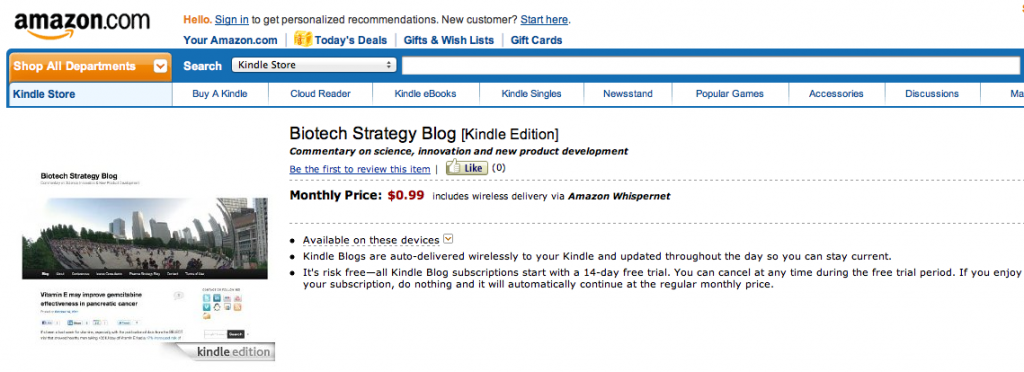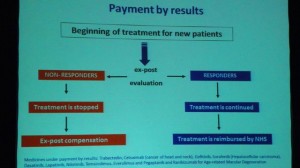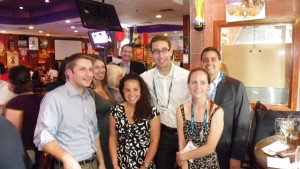 The 2012 BIO CEO & Investor conference starts today in New York.
The 2012 BIO CEO & Investor conference starts today in New York.
The meeting from February 13-14 is being held at the landmark Waldorf-Astoria hotel.
I’m looking forward to seeing some of the iconic hotel features such as the 1893 lobby clock originally produced for the Chicago World Fair.
With Wall Street analysts and investors in mind, the main focus of the 14th annual conference is on publicly traded biotechnology companies.
I expect that a number of the corporate presentations will be webcast, but if you are unable to be in NYC, you can follow the #BIOCEO2012 twitter conversation below:
As always, part of the attraction of these events is the opportunity for networking.
 Rodman & Renshaw are hosting a party at the Rockefeller Center’s sunken plaza restaurant.
Rodman & Renshaw are hosting a party at the Rockefeller Center’s sunken plaza restaurant.
I hope to see you there or at one of the BIO CEO 2012 receptions.
Update Waldorf-Astoria Hotel 8.13 am February 13, 2012
I was all set-up with my trusty Zi8 flip camera to record a few clips of Moncef Slaoui’s fireside chat to share with blog readers, but was publicly told off by BIO staff that I could not shoot any video, despite a media registration. The head of media relations for BIO was not readily available when I asked to speak with her about this.
I’m sorry BIO but you’ve lost the plot. There’s no unpublished scientific data at this meeting, no information that is not publicly available, being webcast or being tweeted. If I’m not welcome, I do have other things to do with my time than attend your meeting, write blog posts about, do a video report & tweet about it. #fail
Update Waldorf-Astoria Hotel 8.58 am February 13, 2012
 After 20 minutes I have given up waiting for a BIO media rep to talk to about the “no video” policy for this meeting.
After 20 minutes I have given up waiting for a BIO media rep to talk to about the “no video” policy for this meeting.
If organizations have a specific photo/video policy for a conference they should take the trouble to communicate this beforehand, at registration or prior to a session starts. Nobody bothered to do that at BIO CEO 2012 today. That’s inept organization.
What BIO did communicate by email to those who registered for BIO CEO 2012 in advance was that:
“By registering for this meeting, attendees authorize BIO to use any photographs taken during the Conference, which may be included in promotion materials.”
BIO could at the same time clearly have indicated any photography/video policy for media or attendees. They didn’t.
In the absence of any specific instruction otherwise and the fact that all attendees had consented to be photographed, I had no reason to believe that video or photography was prohibited.
What’s more, I shot a video report at BIO 2011 that I am sure the folk at BIO were aware of. I received no complaints about it, and if I shot a video report before it would not be a leap of imagination to expect I might shoot another video report.
Nobody likes to be publicly humiliated or told they can’t do something in a public forum after a session has started. I certainly didn’t enjoy that happening to me today.
As a result of my experiences at BIO CEO 2012, Biotech Strategy Blog will not be providing any publicity, promotion or coverage of any future BIO event.
I am sorry if this inconveniences any blog readers. However, on reflection, I don’t think it’s a great loss given that there’s no breaking science or clinical trial data presented at any BIO meeting and company presentations are usually webcast or otherwise publicly available.
 Each day of #JPM17 we’re doing a rolling blog post which we’re updating throughout the day with commentary and insights on the company presentations we’re covering.
Each day of #JPM17 we’re doing a rolling blog post which we’re updating throughout the day with commentary and insights on the company presentations we’re covering. Despite the travel challenges associated with the cold weather hitting much of the United States, many have made [or are in the process of making] the “pilgrimage” to hear leading pharma and emerging biotech companies lay out their strategy and goals for the coming year.
Despite the travel challenges associated with the cold weather hitting much of the United States, many have made [or are in the process of making] the “pilgrimage” to hear leading pharma and emerging biotech companies lay out their strategy and goals for the coming year. Today marks a year since we put up a paywall on Biotech Strategy Blog. While we were sorry to have to restrict access in this way, our decision reflects what is happening in the wider digital media arena, it’s simply not possible to go to conferences and generate quality content for free!
Today marks a year since we put up a paywall on Biotech Strategy Blog. While we were sorry to have to restrict access in this way, our decision reflects what is happening in the wider digital media arena, it’s simply not possible to go to conferences and generate quality content for free! The
The  Rodman & Renshaw are hosting a party at the Rockefeller Center’s sunken plaza restaurant.
Rodman & Renshaw are hosting a party at the Rockefeller Center’s sunken plaza restaurant. After 20 minutes I have given up waiting for a BIO media rep to talk to about the “no video” policy for this meeting.
After 20 minutes I have given up waiting for a BIO media rep to talk to about the “no video” policy for this meeting.


 The most enjoyable part of Day 1 of BIO 2011 for me was the unofficial tweetup at the Old Dominion Brewhouse. Who are the people I have been interacting with on Twitter? Some have twitter handles close to their name, others like me are more cryptic. So at a tweetup it’s common to introduce yourself through the language of twitter, “I’m
The most enjoyable part of Day 1 of BIO 2011 for me was the unofficial tweetup at the Old Dominion Brewhouse. Who are the people I have been interacting with on Twitter? Some have twitter handles close to their name, others like me are more cryptic. So at a tweetup it’s common to introduce yourself through the language of twitter, “I’m  One of the
One of the